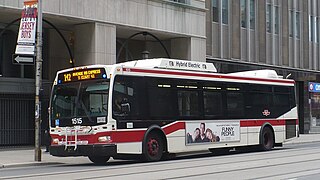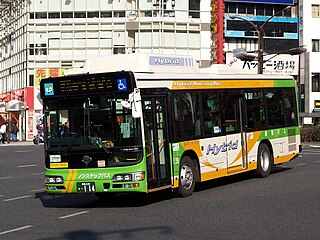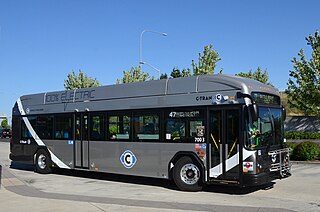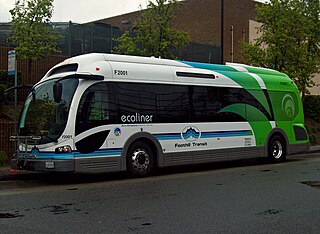
The Mercedes-Benz Citaro is a single-decker, rigid or articulated bus manufactured by Mercedes-Benz/EvoBus. Introduced in 1997, the Citaro is available in a range of configurations, and is in widespread use throughout Europe and parts of Asia, with more than 55,000 produced by December 2019.

The Edmonton Transit Service (ETS) is the public transit service owned and operated by the City of Edmonton in Alberta, Canada. It operates Edmonton's bus and light rail systems. In 2023, the system had a ridership of 87,646,600, or about 308,300 per weekday as of the fourth quarter of 2023.

The Toronto Transit Commission (TTC) uses buses and other vehicles for public transportation. In 2018, the TTC bus system had 159 bus routes carrying over 264 million riders over 6,686 kilometres (4,154 mi) of routes with buses travelling 143 million kilometres in the year. As of 2021, the TTC has 192 bus routes in operation, including 28 night bus routes. In 2023, the system had a ridership of 362,041,400, or about 1,222,800 per weekday as of the fourth quarter of 2023.

A hybrid electric bus is a bus that combines a conventional internal combustion engine propulsion system with an electric propulsion system. These type of buses normally use a Diesel–electric powertrain and are also known as hybrid Diesel–electric buses.

Gillig is an American designer and manufacturer of buses. The company headquarters, along with its manufacturing operations, is located in Livermore, California. By volume, Gillig is the second-largest transit bus manufacturer in North America. As of 2013, Gillig had an approximate 31 percent market share of the combined United States and Canadian heavy-duty transit bus manufacturing industry, based on the number of equivalent unit deliveries.

The Orion VI was a low-floor transit bus available in 40' lengths manufactured by Ontario Bus Industries between 1995 and 2003. The Orion VI was intended to provide an alternative to the existing high-floor Orion V; both the V and VI were replaced by the partially low-floor Orion VII.
Hybrid vehicle drivetrains transmit power to the driving wheels for hybrid vehicles. A hybrid vehicle has multiple forms of motive power.

ISE Corporation was a manufacturer and integrator of heavy-duty hybrid electric powertrain systems for transit bus and truck use, based in San Diego and later Poway, California. ISE was founded in 1995 and filed for bankruptcy in 2010, shortly after raising $20 million in its initial public offering on the Toronto Stock Exchange.

The Orion VII is a line of low-floor transit buses available in 30' rigid, 35' rigid, and 40' rigid lengths manufactured by Daimler Buses North America's subsidiary Orion Bus Industries between 2001 and 2013 in three generations. The conventional powered buses, either with longitudinally-mounted diesel or natural gas engines, used a T-drive transmission coupling. A series hybrid variant powered by a diesel-driven generator was also available. The Orion VII replaced the fully low-floor Orion VI and high-floor Orion V buses, and was manufactured until its parent company DaimlerChrysler withdrew from the transit bus market in 2013.

The MAN Lion's City is a range of low-floor and low-entry public buses built by German truck and bus manufacturer MAN Truck & Bus since 1996 primarily for the European market, but is also available in chassis-only variants worldwide. The name Lion's City has been used since 2006, when MAN's public bus models which had been marketed separately were gathered into one range, when also most models received a facelift. The first models to be introduced were the 12-metre low-floor intercity bus NÜ xx3 (A20) in 1996, the 12-metre city bus NL xx3 (A21) in 1997 and the articulated NG xx3 (A23) in 1998. As with former MAN bus models the power-rating made up part of the model name, giving the NÜ-series buses with power-ratings of 260 and 310 hp model names NÜ 263 and NÜ 313 respectively. The main production sites are in Starachowice and Sady in Poland, but the models have also been built in Germany, Turkey and Malaysia. Initially most of the midibus variants were manufactured by Göppel Bus in Augsburg, later Nobitz.

The Gillig Low Floor is a transit bus manufactured by Gillig since 1997. The second low-floor bus design introduced in the United States, the Low Floor originally served as a second product range for the company alongside the Gillig Phantom. As transit bus operators shifted toward low-floor designs, the Low Floor has replaced the Phantom entirely, becoming the sole vehicle platform offered by the company since 2008.

The New Flyer Xcelsior is a line of transit buses available in 35-foot rigid, 40-foot rigid, and 60-foot articulated nominal lengths manufactured by New Flyer Industries since 2008. In addition to the different available lengths, the buses are sold with a variety of propulsion systems: conventional diesel, compressed natural gas (CNG), diesel-electric hybrid, hydrogen fuel cell, overhead electric wire and battery electric. A future autonomous bus variant was announced in January 2021.
As of 2017, King County Metro operates the 10th largest fleet of buses in the United States, with a total of 1,540 buses.

New Flyer is a Canadian multinational bus manufacturer, specializing in the production of transit buses. New Flyer is owned by the NFI Group, a holding company for several bus manufacturers. New Flyer has several manufacturing facilities in Canada and the United States that produce the company's main product, the New Flyer Xcelsior family of buses.

The New Flyer Invero (D40i) is a line of low-floor transit buses that was manufactured by New Flyer Industries between 1999 and 2007. Produced as a 40-foot (nominal) rigid bus, the Invero was typically sold with a conventional diesel combustion engine, although a few diesel-electric hybrids were built, integrated by Stewart & Stevenson. New Flyer introduced the Invero in 1999 with the intent that it would replace the preceding New Flyer Low Floor line, but few Inveros were sold, and the line was discontinued in 2007; in 2008, New Flyer introduced the Xcelsior, replacing both the Low Floor and the Invero lines.

The NABI LFW is a line of low-floor transit buses available in 30' rigid, 35' rigid, 40' rigid, and 60' articulated lengths manufactured by North American Bus Industries (NABI) between 1997 and 2015. In addition to the different available lengths, the buses were sold with a variety of powertrains, including conventional diesel, LNG, and CNG combustion engines along with a diesel-electric hybrid system

The NABI BRT is a line of low-floor transit buses available in 60' articulated (60-BRT) and later 42' rigid (42-BRT) nominal lengths manufactured by North American Bus Industries (NABI) between 2004 and 2015. In addition to the different available lengths, the buses were sold with a variety of prime movers, ranging from conventional diesel and CNG combustion engines to diesel-electric hybrid.

The Proterra EcoRide BE35 is a 35 foot (11 m) fast-charge battery electric bus that seats 38 with a total passenger capacity of 60 in its composite low floor body. Foothill Transit was the first transit agency to operate the buses in revenue service, starting in September 2010. It is the first 30 ft (9 m) or larger, heavy-duty all-electric bus ever to complete federally required durability, reliability and safety testing at the Bus Research and Testing Center in Altoona, Pennsylvania. The 12yr/500,000 mi (800,000 km) STURAA test was completed on March 5, 2012.

The ENC Axess is a line of low-floor transit buses available in 35-foot and 40-foot nominal lengths manufactured by ENC in Riverside, California starting from 2003. In addition to the different available lengths, the buses are sold with a variety of prime movers, ranging from conventional diesel, LNG/CNG combustion engines, diesel-electric hybrid and hydrogen fuel cell with a traction motor.

The ENC E-Z Rider and its successor E-Z Rider II are a line of low-floor, mid-sized, heavy-duty transit buses available in 30', 32', and 35' nominal lengths manufactured by ENC in Riverside, California starting from 1996. In addition to the different lengths, the buses are available with several powertrain options including traditional diesel, CNG, LNG, Propane, and diesel-electric hybrid.




















